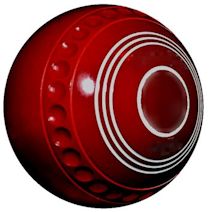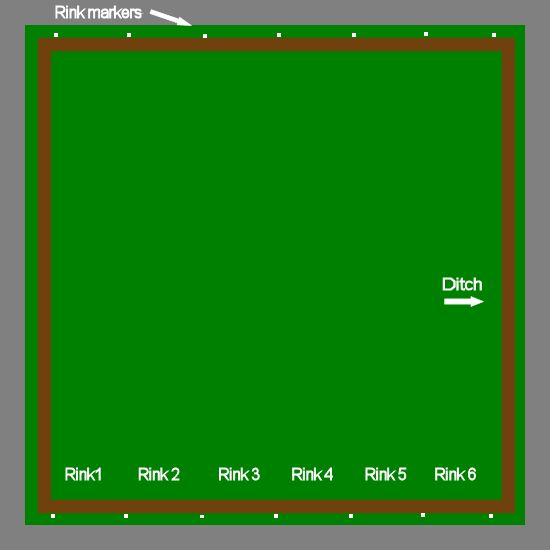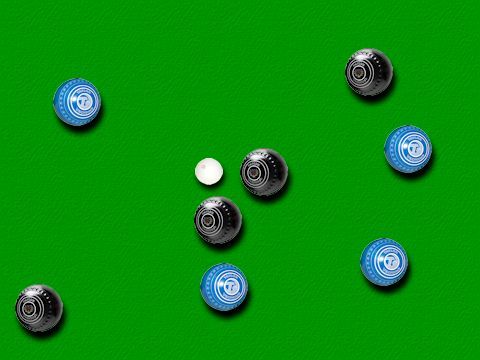Lawn Bowls - The Object of the Game
Introduction
You will not find a comprehensive description of the rules and objectives of Lawn Bowls here but hopefully I can provide an insight into our game and how it is played. You can also read a bit about the history of the game at our Lawn Bowls History page.
You can also download the full copy of World Bowls' the Laws of the Game of Bowls as a PDF.
Like most sports bowls uses its own language so I have provided a glossary of common lawn bowls language at the bottom of this page.
I have also included a Lawn Bowls Frequently Asked Questions page. The answers to these questions refer to the Scottish Bowling Association rules but will be broadly similar in other national associations. Have a look at them, some of them may surprise even the most experienced bowlers.

Playing the Game of Lawn Bowls
It is said that Lawn Bowls is a game that can be played by anyone aged from nine to ninety and in my time in the game I have come across several nonagenarian players. It does tend to have a crusty, "old people's game" image due largely to the use of sponsors like Saga and over 55's insurance companies. The reality is somewhat different and at county level in Scotland the average player's age is probably somewhere in the thirties.
Competitive bowling can be an exhausting game and in matches players are expected to perform for three to four hours without a break. During these games they can walk two or three miles and bend up and down more than  a 100 times. It's no wonder that bowlers traditionally suffer from both back and knee injuries. Add to that the concentration and effort required and you can see why we need a seat and a few beers after the match!
a 100 times. It's no wonder that bowlers traditionally suffer from both back and knee injuries. Add to that the concentration and effort required and you can see why we need a seat and a few beers after the match!
The Game is played on a Bowling Green. The surface is generally grass but in some of the hotter, drier countries artificial surfaces are increasingly being used. In countries with long winters, like the UK and Canada, many indoor bowling centres have sprung up where the game is played on a carpet like surface. While the weight required to deliver the bowl changes on these surfaces the rules and objectives of the game are essentially the same.
Lawn Bowls are available in different sizes with a mid sized men's bowl being between 116mm and 131mm in diameter. They are made of a hard plastic material which is able to withstand the constant contact between bowls during play. Their weight should not exceed 1.59kg.
Until 2001 all lawn bowls were either black or brown in colour. The rules have now been changed to allow bowls in virtually any colour and the manufacturers have taken up the challenge by producing bowls in just about every colour imaginable, even pink! The bottom line is that the colour of the bowl will not help you play any better!
During a game players deliver (roll) their bowls up the green in turn trying to finish closest to a smaller white ball called the "Jack".
A bowling green is normally square and the Scottish Bowling Association rules say that it shall be not less than 34 metres and no more than 40 metres in the direction of play. It is surrounded by a shallow ditch.

The perimeter of the ditch is surrounded by a bank, which should be not less than 230 mm above the surface of the green. The green is normally divided into six "rinks" allowing six games to take place concurrently. The rinks should be not less than 5.5 metres nor more than 5.8 metres wide.

Surface wear is spread by moving the rink settings laterally and by changing direction of play every two or three days, playing either across the green or up and down.
Rink extremities are marked off by boundary markers with the centre of each being indicated by a "pin" which also carries a number for the rink. The rinks are numbered 1 through 6. Players deliver their bowls from one end to another during an "end" then, when the end is complete, they turn around and play back again.
Lawn bowls are not spherical, they are shaped on one side such that they follow a curved track to the jack. They carry a mark to indicate to which side the bias is applied.
As shown on the diagram the bowls can be delivered on the "forehand" (right side of the rink) or the "backhand" (left side of the rink) depending on the players preference or where bowls that have already been played are located. (The diagram refers to a right handed bowler. Fore and Back would be reversed for a left handed bowler.)

The curved path helps the player to find a way past bowls that have been delivered short of the jack. Note that bowls may travel outside the boundaries of the rink during their course as long as they come to rest within these boundaries.
The players must stand on a rubber mat when delivering their bowl. The mat is placed on the centre line of the rink with its front end no less than 2m from the rear ditch or less than 25m from the front ditch. Its position is chosen by the player who throws the jack to start the end. When a bowl is being delivered one of the feet must be on or over the mat as it leaves your hand. Failure to comply with this can be adjudged as foot faulting.
 During an end the bowl nearest to the Jack is referred to as "the shot". You may hear players on the mat asking, "Who is lying the shot?".
During an end the bowl nearest to the Jack is referred to as "the shot". You may hear players on the mat asking, "Who is lying the shot?".
The player who first delivers the jack must ensure that it is properly centred. If it comes to rest within two metres from the front edge of the green it must be moved out to a mark at that distance. The player delivering the jack can choose the length to play it, but it must finish at least 23m in a straight line of play from the front edge of the mat.
The players then take turns to deliver their bowls. When all the bowls have been delivered the number of "shots" is counted. A shot is a bowl which is nearer the jack than any of your opponents bowls. For example, if you have three shots nearer the jack than any of your opponents bowls you score three shots at that end.
In this image, at the conclusion of a typical end of bowls in a singles match each player has has played four bowls. The player using the black bowls has two bowls nearer the jack than his opponents nearest blue bowl. This means that the player with the black bowls counts two shots.
Types of Lawn Bowls Games and Matches
Games of bowls can involve singles play or teams of two in pairs, three in triples or four in "rinks" games. Matches generally involve a number of teams from one club playing another club. For example a match could involve six rinks or 24 players (6x4) per team.
The jack can be moved by the bowls during play. When a bowl moves the jack it is left in the new position provided it remains within the rink boundary markers. It can also be pushed into the ditch by a bowl. In this case it remains in the ditch and the players must try to play their bowls as close as possible to the jack, at the edge of the green, without falling into the ditch.
A bowl which moves the jack is marked with chalk and classed as a "toucher". If it touches the jack before falling into the ditch it stays there, remains "live" and may feature in the final shot count. A toucher that remains on the rink and is later driven into the ditch by another bowl is also a live bowl. A bowl that goes into the ditch and that has not touched the jack is classed as being "dead" and it is removed. All bowls which finish outside the side boundaries of the rink are dead.
Lawn Bowls Tactics
Bowls is a highly tactical game. This is one of its attractions. It is not always about "drawing" closest the jack. Players must constantly anticipate what shot their opponents may consider playing next. For example when a team has a few bowls behind the head, (behind the jack), the opposing team may see the need to place a bowl amongst these to cover the possibility of the jack being moved.
Similarly, if one side is already lying the shot, they may elect to play a guarding shot short of the target area to prevent their opponents from moving anything. These are only two examples and there are many other situations, too many to discuss here, where tactics come into play.
Types of Shots in Bowling
There are basically four different types of shot, or delivery in Lawn Bowling. These are ...
The Draw
A Drawing Shot is the most common and it is really what the game is all about. This shot is the one in which the player attempts to play with the exact weight required to finish closest to the jack or to a point on the green dictated by strategy or tactics. This shot is often considered to be the most skilful.
The Yard On
The "Yard On" shot is when the player delivers a bowl with enough weight to carry it a yard or two past the target. The objective of this shot is usually to drag the jack away from the opponent's bowls towards your own or to push a bowl out of the "head" and take its place. This is often referred to as a "chap and lie" shot in Scotland.
The Running Shot or Ditch Length Shot
The Running Shot is one which uses more weight than the yard on. The object of this shot is to remove opponents bowls from the head, to move the jack to the ditch or to seek some other result that requires the bowl to be played with weight. This can be a difficult shot to play as the line (bias) required to get to the target changes with different weight.
The Drive
The Drive is probably the most spectacular shot on the bowling green. A drive is when the player delivers the bowl at high speed and with maximum weight so that he can strike the head or the target with full force. The object of this shot can be to completely remove opponent's bowls from the head or from the rink or to drive the jack into the ditch. It is also commonly used when a player has a few shots against him. In this case the object is to destroy the head or to "burn" the end by driving the jack out of the rink. This can be a very effective and intimidating shot to have in your armoury but many players have difficulty controlling their direction when concentrating their efforts on so much weight.
Well, that's a brief introduction to the game of bowls that should give you some idea what it's all about. Hopefully, for those of you who don't play the game but watch it on television, it will make your viewing more enjoyable.
If you have any questions or comments on the above or if you see any errors or typos please feel free to email me but bear in mind that we are not an official body. We cannot answer formal questions on the rules the game.
Lawn Bowling Glossary
| Term | Definition |
|---|---|
| Bias | Bias is the amount of curve that a bowl will take during its course to the jack. Bowls are available with several different biases for use in different conditions and competitions. As part of the manufacturing process all bowls are tested against "Master Bowl", which defines the limits of this bias |
| Burnt End | A Burnt or Burned end is one where the Jack has been moved outside the boundaries of the rink by a bowl in play. In normal competition burnt ends must be replayed |
| Deliver | Deliver is the word used to describe the throwing or rolling a bowl. The delivery is the action of delivering a bowl. A bowler with a good delivery can be compared to a golfer with a good swing. |
| Draw | The term Draw can have several meanings in bowling. As a noun it can refer to the type of shot being played. A "dead draw" is an attempt to deliver the bowl as close as possible to the target (generally the jack). It can also be used as a verb. You may hear a skip issuing an instruction such as, "Just draw to the jack". |
| Drive | A Drive is type of shot in bowling where the player delivers the bowl with maximum force toward the target. Otherwise know in Scotland as a "blooter"! |
| End | Bowls are played from one end of the green to the other alternately. An "end" of bowls comprises the placing of the mat, the delivery of the jack and the delivery of all the bowls of all of the players in one direction on the rink. |
| Guard | A Guard is a bowl played to a position that restricts the opposition from getting to the target. Can also be known as a "policeman". |
| Head | The Head refers collectively to the Jack and the bowls that have been delivered and have come to rest within the boundaries of the rink.. |
| Heavy | When a player unintentionally delivers a bowl beyond the jack or the intended target it is described as being Heavy |
| Jack | The Jack is the small white ball that is the target in bowls. You may also hear it referred to colloquially as the "White", the "Kitty" or the "Sweetie". |
| Jack High | If a bowl is Jack High it means that it has reached a position such that its nearest part is laterally aligned with the jack. Effectively it means that the bowl and jack are precisely equidistant from the mat. |
| Lead | A Lead is the person who plays first in pairs triples or fours (rinks) game. The lead is responsible for setting the mat and delivering the jack to start the end. |
| Line | The Line or Road is the curved route taken to the jack. E.g. "You are a yard short but your line was good." |
| Second | The Second in a triples or rinks (fours) game is the player who plays second. In the rinks game the second is normally responsible for marking the score card. |
| Short | A bowl that does not reach the jack or the intended target is described as being Short. |
| Shot | Shot can have several meanings. The shot or shots are the number of points scored in an end. It can also mean the type of delivery, e.g. a drawing shot, and during an end, it can be used to describe the bowl that is currently nearest the jack. |
| Skip | The Skip is the captain of a team in pairs, triples or rinks play. The Skip is always last to play and is responsible for directing the play during an end. The other players in a team must follow the Skip's instructions. |
| Third | The Third is the third player to play in a fours (rinks) game. The third is normally responsible, with his corresponding opponent, for deciding the result of an end, i.e. who is lying the shot and how many shots have been scored. The skips however have the final say in this in the event of any dispute. |
| Toucher | A Toucher is a bowl that during its course touches the jack before finishing within the boundaries of the rink. A toucher remains live even if it finishes in the ditch. |
| Weight | Weight is the term used to refer to the power applied to a delivery. |
| Woods | Before the introduction of plastic composition bowls they were made from the heaviest most dense wood available, Lignum Vitae. At this time bowls were often called Woods and some people still use this as a generic term for bowls. |
If you think that any other lawn bowling definitions should be included please let us know and we will add them.
Here are some more on Wikipedia.

